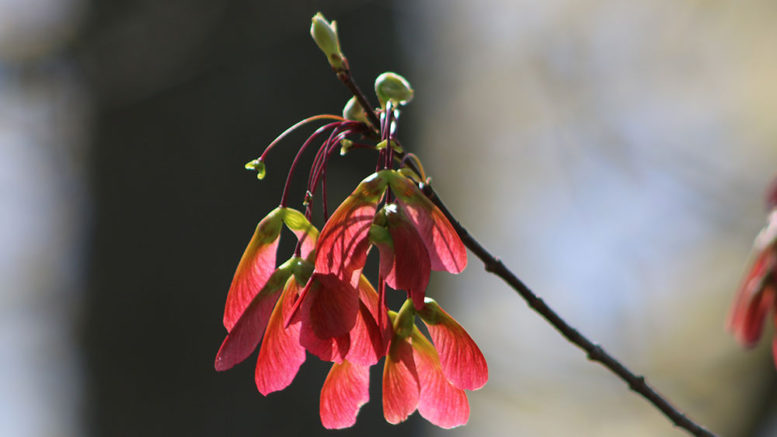Talkin’ Trees
 It’s spring. The trees are groaning and stretching as they again start their full-time job of taking care of us. These largest plants on earth are busy cleaning our air, water, and providing physical, mental and emotional benefits.
It’s spring. The trees are groaning and stretching as they again start their full-time job of taking care of us. These largest plants on earth are busy cleaning our air, water, and providing physical, mental and emotional benefits.
In this time of environmental stress, it is increasingly important to conserve, protect, and plant trees. Healthy trees and woodlots offer multitudes of benefits. They are not the single cure for the stresses the Earth is experiencing, but they are a major part of the answer.
Think about drops of rain. Follow a drop in your mind as it plops down and meanders its way to the storm sewers, picks up more drops, gaining speed as they make their way downhill. As the drops move along at a faster pace, they pick up oils, dirt, trash, and other varied surface pollutants before they rush into the gutters and drains and make their way to our streams, creeks, rivers and lakes.
Without trees, there is no tree canopy to slow the pelting rain, and no leaves, trunk, or roots to trap pollutants. Without trees, that raindrop and its buddies are not going to be pure or semi-pure when they finally enter our water supply.
Newly planted and mature trees in woodlots and forests intercept stormwater and pollutants from rain events. I visited a 41-inch Tulip tree (Liriodendron tulipifera) at Forest Park and plugged its vital statistics into an application called i-Tree. That tree intercepts 2,920 gallons of rainfall annually, while a young eight-inch Tulip tree I measured intercepted 385 gallons of rainfall this past year (i-Treetools.org).
The more woodlands preserved and protected, the more trees planted in rural yards and urban landscapes, the cleaner the air. The leaves, twigs, bark and roots of trees are effective air filters and pollution captors.
For example, carbon dioxide (CO2) is naturally present in the air, but, due to human impact, there is much more than the 0.03 percent that naturally occurs. In fact, there is more CO2 in the air now than at any other time since consistent measurements of it began in 1958 (Yale School of Forestry).
Trees and all green plants via photosynthesis take in carbon dioxide, store it, and release oxygen as a byproduct. In fact, the 41-inch diameter Tulip tree at the park, stores 24,363.43 pounds of CO2 (i-Treetools.org).
If one large tree can do that, think about what a grove of trees will do in their lifetime … or a woods … or a small woodlot … or the trees in your backyard. These pollution fighters also remove carbon monoxide, ozone, nitrogen and sulfur dioxide, and trap particulate matter from the air.
In comparison, the young Tulip tree is storing 607.57 pounds of carbon. Tulip (our state tree), Oak, Maple, Hackberry, and small to medium species all provide benefits. However, the larger the tree at maturity, the more benefits we receive. So, it is important to conserve, protect, and plant large maturing species.
Here is something to consider from USDA Forest Service researchers. One acre of trees annually absorbs the amount of CO2 of a car driven 26,000 miles and puts out four tons of oxygen, which is enough to meet the annual clean air needs of 18 people.
Yet, what do we see in Hamilton County and throughout Indiana? We see bulldozing of woodlots, woodlands and edges, which inhibits cleaner air and water, and destroys habitats for birds, insects, reptiles, amphibians, fish and mammals. The destruction of woodlands and edges hurts humans in other ways as well.
Take a break from COVID-19. Visit McGregor, Koteewi, Cool Creek, or Carmel’s Central Park. Lean on the rail of the Rookery Preserve. Breathe in the cleaner air, sit or amble along and enjoy the trees and plants in your line of sight. Wow! Blood pressure and stress levels drop.
The early research of USDA Forest Service and university scientists has proven that when we have a view of trees or walk among the trees, we enjoy the physical response of destressing. Trees have numerous physical and mental benefits. There are too many to digest in a short column. Now that you have time, you may want to hit the search button and learn a bit more.
We are coming up on Arbor Day on April 24. It is not only a time to plant trees, but also time to thank the trees for the services they provide. The trees will only continue to provide these services if new ones are planted, the woodlands are conserved and protected, and trees on private and public lands well cared for and respected for the jobs they do for us.
In fact, now, is a great time to give a tree a well-deserved hug. It’s OK. Trees do not require social distancing.
Pamela Dunn-Louks, owner of In2Trees, is an ISA Certified Arborist, has a BA in Journalism from St. Mary of the Woods College, and is a nature photographer. Since retiring from the Indiana DNR as the state Community & Urban Forest Coordinator, she spends time visiting trees and offering tips and tools of the trade for their healthy upkeep. She is a lifelong resident of Hamilton County who lives in Cicero – with a lot of trees. Contact her at pam@in2trees.com.

